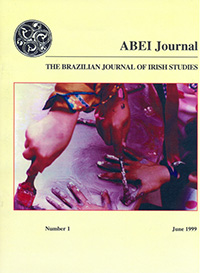The Feminization of Famine by Margaret Kelleher. The Author's Response to Maureen Murphy’s Article
DOI:
https://doi.org/10.11606/issn.2595-8127.v1i1p21-22Palavras-chave:
Fome, Feminização, História irlandesa, GêneroResumo
My study, The Feminization of Famine, was published in 1997 and thus became part of the commemoration of the 150th anniversary of the Great Insh Famine (1845-1851). As a doctoral] student in Boston College, I became interested in the very different images of famine portrayed in Irish texts, ranging from Anthony Trollope's Castle Richmond (published in 1860 and based on Trollope’s observations while living in Ireland during the famine period) to Liam O'Flaherty’s novel Famine (first published in 1937 and arguably the most successful Irish famine narrative).
Referências
Boland, Eavan. Object Lessons: The Life of the Woman and the Poet in Our Time. Manchester: Carcanet, 1995.
Dalsimer, Adele. Visualizing Ireland: National Identity and the Pictorial Tradition. London and Boston: Faber and Faber, 1993.
Dalsimer, Adele and Vera Kreilkamp (eds), Re/Dressing Cathleen: Contemporary Works from Irish Women Artists. Boston: McMullen Museum of Art, 1997.
Gray, Peter The Irish Famine New Horizons Series. London: Thames and Hudson, 1995.
Marshall, Catherine. “Painting Irish History: the Famine”, History freland vol. 4 n° 3 (1996), pp. 46-30.
O Grdda, Cormac. The Great trish Famine. Studies in Economic and Social History. London: Macmillan, 1989.
---, An Drochshaol: Béaloideas agus Amhrdin [The Famine: Folklore and Song}. Dublin: Coiscéim, 1994,
Warner, Marina. Monuments and Maidens: The Allegory of the Female Form. London: Picador, 1985.
Downloads
Publicado
Edição
Seção
Licença
Copyright (c) 1999 Margaret Kelleher

Este trabalho está licenciado sob uma licença Creative Commons Attribution-NonCommercial 4.0 International License.


